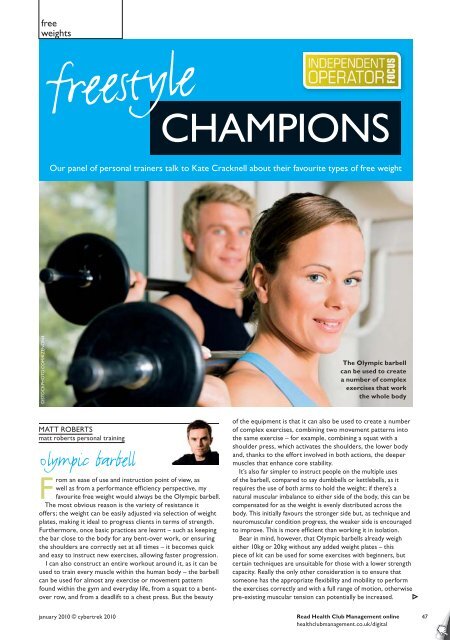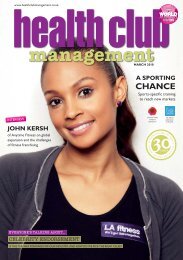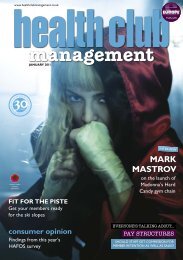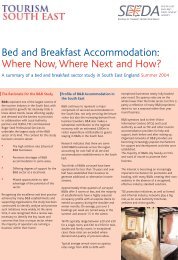Health Club Management issue 1 2010 - TourismInsights
Health Club Management issue 1 2010 - TourismInsights
Health Club Management issue 1 2010 - TourismInsights
You also want an ePaper? Increase the reach of your titles
YUMPU automatically turns print PDFs into web optimized ePapers that Google loves.
free<br />
weights<br />
<br />
CHAMPIONS<br />
Our panel of personal trainers talk to Kate Cracknell about their favourite types of free weight<br />
©ISTOCKPHOTO.COM/KZENON4<br />
The Olympic barbell<br />
can be used to create<br />
a number of complex<br />
exercises that work<br />
the whole body<br />
MATT ROBERTS<br />
matt roberts personal training<br />
<br />
rom an ease of use and instruction point of view, as<br />
well as from a performance efficiency perspective, my<br />
F favourite free weight would always be the Olympic barbell.<br />
The most obvious reason is the variety of resistance it<br />
offers; the weight can be easily adjusted via selection of weight<br />
plates, making it ideal to progress clients in terms of strength.<br />
Furthermore, once basic practices are learnt – such as keeping<br />
the bar close to the body for any bent-over work, or ensuring<br />
the shoulders are correctly set at all times – it becomes quick<br />
and easy to instruct new exercises, allowing faster progression.<br />
I can also construct an entire workout around it, as it can be<br />
used to train every muscle within the human body – the barbell<br />
can be used for almost any exercise or movement pattern<br />
found within the gym and everyday life, from a squat to a bentover<br />
row, and from a deadlift to a chest press. But the beauty<br />
of the equipment is that it can also be used to create a number<br />
of complex exercises, combining two movement patterns into<br />
the same exercise – for example, combining a squat with a<br />
shoulder press, which activates the shoulders, the lower body<br />
and, thanks to the effort involved in both actions, the deeper<br />
muscles that enhance core stability.<br />
It’s also far simpler to instruct people on the multiple uses<br />
of the barbell, compared to say dumbbells or kettlebells, as it<br />
requires the use of both arms to hold the weight; if there’s a<br />
natural muscular imbalance to either side of the body, this can be<br />
compensated for as the weight is evenly distributed across the<br />
body. This initially favours the stronger side but, as technique and<br />
neuromuscular condition progress, the weaker side is encouraged<br />
to improve. This is more effi cient than working it in isolation.<br />
Bear in mind, however, that Olympic barbells already weigh<br />
either 10kg or 20kg without any added weight plates – this<br />
piece of kit can be used for some exercises with beginners, but<br />
certain techniques are unsuitable for those with a lower strength<br />
capacity. Really the only other consideration is to ensure that<br />
someone has the appropriate fl exibility and mobility to perform<br />
the exercises correctly and with a full range of motion, otherwise<br />
pre-existing muscular tension can potentially be increased.<br />
january <strong>2010</strong> © cybertrek <strong>2010</strong><br />
Read <strong>Health</strong> <strong>Club</strong> <strong>Management</strong> online<br />
healthclubmanagement.co.uk/digital<br />
47
















